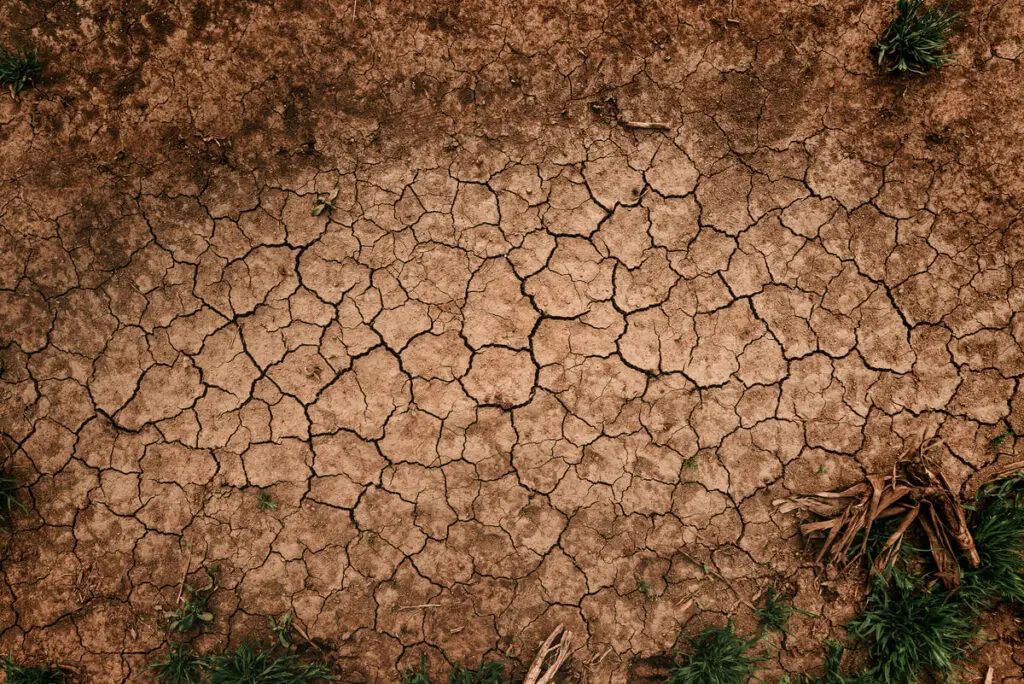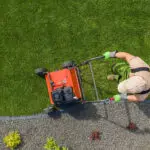A healthy lawn starts with good soil, which can be seriously compromised by soil compaction. But what is soil compaction exactly? Lawn Master is here to help us understand.
Healthy soil has lots of space, also called “pores”, which allow for gas exchange, water absorption, and root growth. With soil compaction, these pores get squished down and harm the health of the lawn.
The effects of Soil Compaction
Soil compaction impacts our lawns and gardens in several unpleasant ways. Fortunately the symptoms are easy to diagnose if you know what to look for.
Yellow and brown patches of grass, and wilting, sickly-looking leaves, are often signs of compaction. It happens due to reduced pore size, which results in less oxygen and water availability for root systems. Smaller pores also creates an uninhabitable environment for earthworms and beneficial microbes.
Reduced pore size means less oxygen and water available for the plants roots. This can show up as yellow and brown patches of grass, as well as wilting and sickly looking leaves. It also provides an uninhabitable environment for healthy organisms such as earthworms and beneficial bacteria.
Weeds and other pests are quick to take advantage of unhealthy soil conditions. Unyielding soil makes it much harder for grass roots to expand outwards to find nutrients and water. However, weeds are much hardier and steal limited pore space and resources.
Drainage issues can arise because water has a harder time absorbing into dense soil. Additionally, soil sometimes forms a water-resistant crust following heavy rain. This results in puddles, runoff, and soil erosion. In healthy conditions, larger pores absorb water deep into the earth.
Soil Compaction: Causes and solutions
Below are some of the main reasons for compaction, and practical preventative measures which can be taken by any home or business owner:
Foot traffic – Outdoor activities such as a party or children running around, will compress soil over time. Try to limit foot traffic when possible, especially following rainfall. For daily traffic, you can put down stepping stones, gravel, or mulch. And for traffic due to construction, consider laying down temporary plank pathways.
Heavy equipment – Whether you’re stacking lumber in your yard or parking cars on it, the weight will compress the soil over time. This also goes for heavy duty lawn mowers. If possible, substitute heavy equipment for lighter whenever practical. Proper tire inflation and flotation will also help with weight distribution.
Heavy rainfall – Some compaction is caused by natural circumstances and out of our hands. During rainy seasons, soil can form water resistant crusts and is also much more prone to further compaction. It’s important to avoid yard work or foot traffic closely following rain.
Over tilling – Tilling the soil means to overturn it, which is done to mix moist nutrient-rich soil buried underneath with the topmost layer. In small amounts, tilling is beneficial. When overdone, it hurts the plants and compacts the soil. Try not to do any tilling following rain.
How to test your soil
A quick DIY test for compaction, is the screwdriver test. All you need to do is push a screwdriver about six inches into the earth. If it takes a lot of effort, that indicates compaction.
A similar test can also be done with a spade or shovel. If you manage to dig up a small section of compacted soil, you’ll discover shallow roots and tiny pores. The same test can be done with a soil probe, which is essentially a hollow tube you push into the ground that pulls up soil samples.
To be extra safe, find out the locations of utility and sprinkler lines before digging around.
How to fix and prevent soil compaction
Sometimes even when you do everything right, soil still gets compacted. Fortunately there are ways to quickly reverse the damage.
Mulching – Mulch is great for laying over areas of bare soil, to prevent water-resistant crusts from forming following rainfalls. For lawns with high foot traffic, a mulch pathway looks a lot nicer than trampled grass, and serves as a clear walkway for people to walk on. As organic mulch breaks down, it also adds nutrients to the soil.
Compost – Following aeration, it’s good to spread a light layer of compost “top dressing” on the soil. As it breaks down and absorbs, it increases organic matter within the soil, and attracts helpful insects that act as natural aerators. Soil with high levels of organic matter is better at resisting future compaction, and is more drought-resistant.
Core Aeration – This is perhaps the best thing you can do to repair compacted soil. Aeration puts holes into the ground using hollow tines, which helps reestablish healthy water and gas exchange beneath the surface. Aerating once or twice a year is usually sufficient to maintain ideal conditions.
If you’re in Ada or Canyon County, Idaho and your lawn needs professional care, reach out to Lawn Master. Give us a shout at (208) 989-9261 and we’ll have a qualified specialist over to assess your property in no time!



